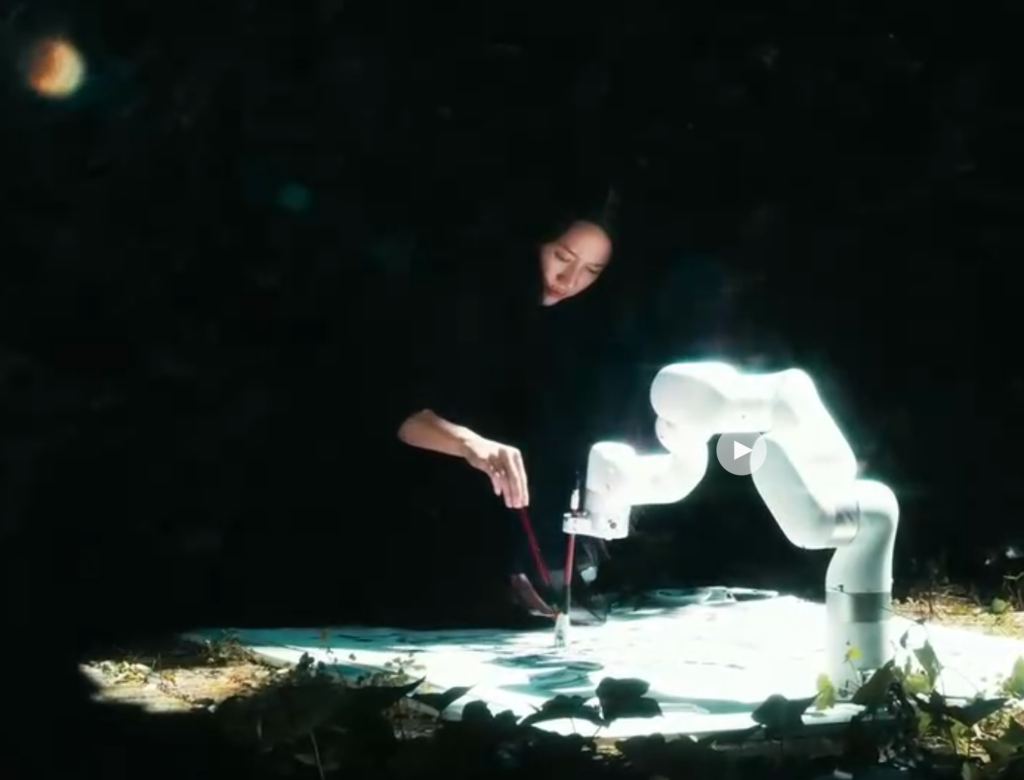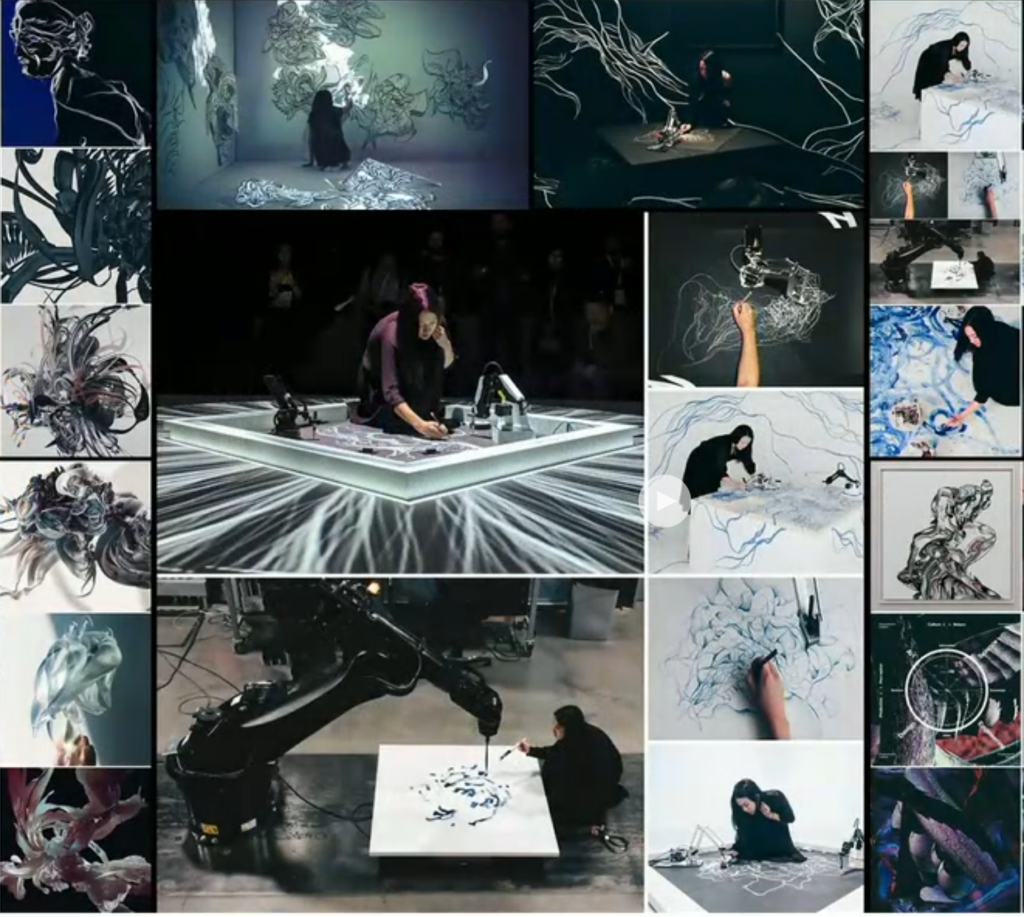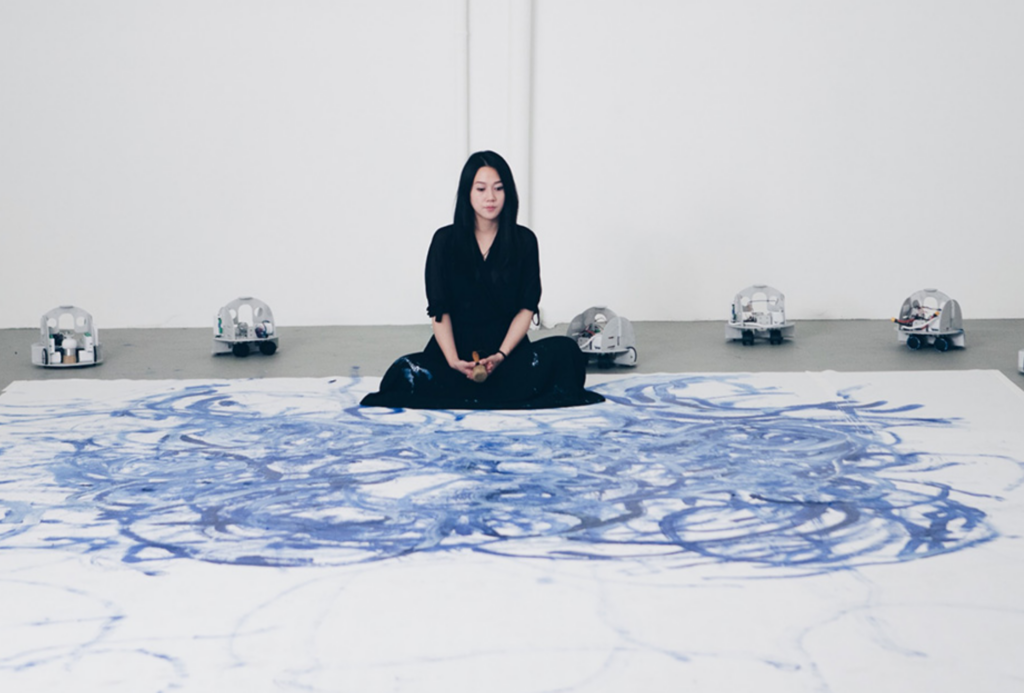Relational intelligence and performance artist Sougwen Chung.

Sougwen Chung is an artist and engineer whose exhibitions and performances have taken place in galleries and museums all over the world. At Siggraph 2022 in Vancouver, she gave the keynote speech titled Seeing Double.
She began her talk by saying two sets of eyes take in the same scene, the same light comes through two apertures that see two completely different things—one is biological and one is mechanical—as a result, we’re seeing double. It’s the double view of machine vision of security cameras, satellites, robots, and social media.
Chung suggested that the hybrid nature of AI systems and technology interacting with us, including robotics, can point to a bleak future. We’re already asking questions about whether machines will replace workers but will machines replace artists too? It’s hard to look at a headline today without feeling anxiety—will we be replaced; will we replace ourselves? Or will the machines somehow save us through technological advancement? Will they liberate or fulfill our anxiety? Keep us safe and healthy in a way nature never could? Will they offer us a way to transcend evolution? This duality, the promise of its power and the anxiety of its consequences shape Chung’s world view, and she says it shapes us all.
She then described her performance art using robots to produce large images and exploring the contradictions that extend from dual visions. She suggests exploring how these contradictions point to a third path, a new hybridity.
She also demonstrated how she has been teaching robots to mimic her painting styles.

She looks to art to serve as a bridge between these conditions. Not to resolve them into some new cohesive whole, but to entangle them and to highlight the entanglement that has already taken hold.
Chung says: paintbrush and pixels, art and engineering, human creativity and artificial intelligence, it’s about engaging in an active process of reconciliation, past cynicism or optimism, and exploring conditions in the natural and the mechanical, exploring the medium itself. She believes art is a process of thinking and the process involves ritual. All rituals, old and new, are vital forms of world-building, a way that fear and hope can be held in the mind at the same time.
The exploration Chung undertakes in her work goes beyond using machines. To create, she collaborates with machines treated with compassion and imbued with perceived agency but understood as the product of human beings and not as peers in thought. She calls for more syncretic disciplines to bridge the conditions that exist between humans and machines. She’s looking for ways to unify multiple traditions.
Far from fearing the encroachment of machines into the world of art, Chung identifies AI and computation are ways to expand art and what art can become. Chung proposes the idea of art as cognitive science, exploring alternative forms of consciousness. Or, art as engineering, constructing robotic systems for empathy and connection. And, art as philosophy imagining new worlds and moral constructions for the human-machine relationship.
At the intersections of those fields, she and her team create simulations, performances, and artifacts and work on a large scale such as relational robotic performance integrating satellite and biofeedback.

Chunk says they are looking for that gray area between humans and machines and stumbled upon it in a series called Drawing Operations.
She then showed several examples of using the robot to co-create various art pieces.
Chung said she gets her inspiration from Cybernetics but going a step further with her ideas of entanglement and hybridity. For instance, artificial reality, the combination of machine vision and human vision, is not a thing apart. Chung says the artificial reality is us in a different form.
From that point, she says she uses artificial reality as an extension of herself as artist, using artificial reality to augment her own simple drawing processes through recurring neural networks and robotics. She says the exciting thing about this notion of the artificial is that it really unseats it. It’s a mirror and almost a distorted mirror so it becomes a creative catalyst for different research prompts.
During her talk, she was asked if she could predict any of the outcomes of working in the hybrid space, what role does uncertainty play in her work? She says, she found that the bugs in the original work became features, part of the original texture. That outcome, that uncertainty—I can’t simulate the outcome in my mind. She says.
Her notion of what becomes a successful output comes from the intuition of balance over time and if the robotic arm feels like it is drawing in a naturalistic way—it’s about the movement and the improvised generative choreography that creates the relational feedback. She tries to think about what feels like a drawing process, rather than what looks like a drawing process.
She was asked, how the symbiotic relationship she has developed with AI and robotics actually works. Where is the push and pull within the process? When does she push back on the process and input patterns and does she reflect upon the process? Is it more during the emergent performance or does it come at the end as she reflects upon that session?
She says that she tries to break the system, to break her own expectation and it came to feel something like playing an instrument, which is how the act of performance evolved. She says she uses performance on a stage as a demo and she may go back and massage the data and design a better affecter. That became the flow.
But as she continued to do the work, (she’s been doing this ongoing project for 10 years), she wanted to bring more of her own biofeedback into the piece so the latest generation (gen 4) is triggered by the alpha state of her brainwave when she’s in process and that determines the level of the signal-to-noise of the drawn line and in that way, it becomes different every time and beyond the reach of her control and that creates a special performance.
She was asked if she could consider AI and robotics as an artist, or at what point she might consider it, or is it only human driven. She answered that everyone is an artist. And she repeated her ideas about art being a meaning-making machine. Chung is interested in the art we make when we look at non-sentient systems and assign meaning, agency, and anthropromorphism to it so the real evolution of art isn’t in machines as artists but in broadening our ideas of what art can be, which changes. A decade ago, she notes, a lot of engineering practices wouldn’t be considered art, but now, of course, we know it is and that evolution is the real art practice moving forward.
She is working on trying to connect the robotic movement to broader inputs and systems which is why she was interested in using her biofeedback which isn’t a drawing or image. Trying to connect the work of live satellite data for instance is almost like connecting it to nature. She loves the idea of connecting it to the natural world because she thinks that will really foreground the uncertainty of our environment and there’s really something very exciting about creating new expressions for that flow.
https://siggraph2022.hubb.me/fe/schedule-builder/sessions/941352






